1950-1959
1959 Cadillac Fleetwood
- Details
- Written by Big Block
- Category: 1950-1959
- Hits: 2668
1959 Cadillac Fleetwood
| SERIES SIXTY SPECIAL FLEETWOOD |
| Model Number | Body Style | Model | Seating | Factory Price | Shipping Weight | Production Total |
SERIES SIXTY SPECIAL FLEETWOOD | ||||||
| 59-60 | 6029M | 4-door Hardtop Sedan | 6 | 6233 | 4890 | 12,250 |
SERIES 6700 FLEETWOOD 75 | ||||||
| 59-67 | 6723R | 4-door Sedan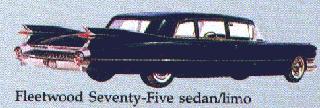 | 9 | 9533 | 5490 | 710 |
| 59-67 | 6733S | 4-door Imperial Sedan | 9 | 9748 | 5570 | 690 |
| 59-68 | 6890 | Commercial chassis | - | - | - | 2,102 |
| FLEETWOOD ENGINES |
- V-8 Overhead valves
- Cast iron block
- Displacement: 390 cubic inches
- Bore and stroke: 4.00 x 3.875 inches
- Compression ratio: 10.5:1
- Brake horsepower: 325 at 4800 rpm
- Five main bearings
- Hydraulic valve lifters
- Carburetor: Carter AFB four-barrel Model 2814S
| SERIES 6700 FLEETWOOD 75 |
The long wheelbase Fleetwood’s were still called Seventy-Fives, although a new numerical series designation was in official use. Production models again were a nine-passenger sedan and Imperial sedan-limousine with auxiliary jump seats. Fleetwood lettering appeared on the rear deck lid trim strip. Single side trim moldings extended from the front wheel housing to the rear of the car. Standard equipment included all items found on the Sixty Special Fleetwood line.
| CHASSIS |
| Feature | Fleetwood 60S | Fleetwood 75 |
| Wheelbase | 130" | 149.75" |
| Overall Length | 225" | 244.8 |
| Tires | 8.00 x 15 | 8.20 x 15 |
| Dual exhausts standard | ||
| Rear axle ratios | 2.94:1 standard; 3.21:1 optional or mandatory with air conditioning | 3.36:1 standard; 3.77:1 optional; 3.21:1 with air conditioning |
| POWERTRAIN OPTIONS |
The 345 horsepower Eldorado V-8 was optional on all other Cadillacs at $134.30 extra.
| CONVENIENCE OPTIONS |
- Radio with rear speaker ($165)
- Radio with rear speaker and remote control ($247)
- Automatic heating system on Series 75 ($179); on other models ($129)
- Six-Way power seat on 6200s except convertible ($189)
- Six-Way power seat on 60-6306-6400 and 6200 convertible ($89)
- Power window regulators ($73)
- Power vent regulators ($73)
- Air conditioning on Series 75 ($624); on other models ($474)
- Air suspension ($215)
- Autronic Eye ($55)
- Cruise Control ($97)
- Electric door locks on two-doors ($46); on four doors ($70)
- E-Z-Eye glass ($52)
- Fog lamps ($46)
- White sidewall tires 8.20 x 15 four-ply ($57 exchange)
- 8.20 x 15 six-ply ($65 exchange).
- Door guards on four doors ($7)
- Door guards on two doors ($4)
- Remote control trunk lock ($59)
- License Plate frame ($8)
- Local options
- Utility kit ($15)
- Monogram ($12)
- Acryllic Lustre finish ($20)
- Undercoating ($25)
- Radio foot switch($10)
- Gas cap lock ($4)
- Pair of rugs for front ($8)
- Pair of rugs for rear ($5)
- Note: Bucket seats were a no-cost option on the Biarritz convertible
| HISTORICAL |
- Assembly of 142,272 units was counted for the 1959 model year.
- This was the next to last season for selling the Brougham.
- Flat-top roof styling was used on four-window sedans
- Six-window jobs had sloping rooflines with rear vent panes.
- Power steering and shock absorbers were improved this year.
1959 Cadillac Eldorado
- Details
- Written by Big Block
- Category: 1950-1959
- Hits: 2913
1959 Cadillac Eldorado
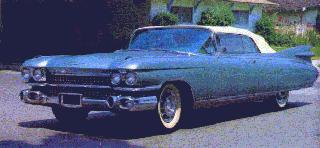 Model year 1959 brought another complete restyle for the entire Cadillac line and -- except for the Eldorado Brougham -- the wildest tailfins Detroit would ever produce. Cadillac historian Walter McCall described these appendages as "flamboyant," "ludicrous" and "of questionable taste." Other critics have said harsher things, but the public seemed to go along with the excess. The economy had picked up somewhat and, as elsewhere in the industry, Cadillac sales improved a bit. Air suspension, pioneered by the Brougham two years earlier, was now standard for Biarritz and Seville. Though it offered a cloud-like ride and the convenience of automatic self-levelling in response to changes in load, the airbag setup was leak-prone and troublesome. Cadillac would abandon it after 1960 as Detroit's fascination with such gimmicks waned in proportion to a growing number of customer complaints.
Model year 1959 brought another complete restyle for the entire Cadillac line and -- except for the Eldorado Brougham -- the wildest tailfins Detroit would ever produce. Cadillac historian Walter McCall described these appendages as "flamboyant," "ludicrous" and "of questionable taste." Other critics have said harsher things, but the public seemed to go along with the excess. The economy had picked up somewhat and, as elsewhere in the industry, Cadillac sales improved a bit. Air suspension, pioneered by the Brougham two years earlier, was now standard for Biarritz and Seville. Though it offered a cloud-like ride and the convenience of automatic self-levelling in response to changes in load, the airbag setup was leak-prone and troublesome. Cadillac would abandon it after 1960 as Detroit's fascination with such gimmicks waned in proportion to a growing number of customer complaints. Eldorado horses again numbered 20 more than on other Cadillacs. Thanks to a longer 3.88-inch stroke and another compression tweak, the figure was now 345 for the newly enlarged 390-cid V-8, which would prove to be the all-time power peak for a rear-drive Eldo. Echoing 1954, the Biarritz and Seville lost much of their previous styling distinction this year.
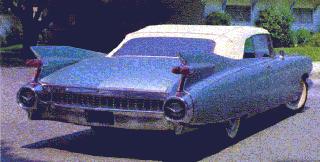 Their only differences from comparable Series 62s were a chrome swath along the upper rear fender contour and the Eldorado name in neat block letters along the lower edge of the front fenders. (The Brougham was another matter entirely. Now bearing coachwork built and styled by Pinin Farina of Italy, it was far different in character than the 1957-58 design and actually predicted a number of styling features that would be adopted for the regular 1961-62 production models.)
Their only differences from comparable Series 62s were a chrome swath along the upper rear fender contour and the Eldorado name in neat block letters along the lower edge of the front fenders. (The Brougham was another matter entirely. Now bearing coachwork built and styled by Pinin Farina of Italy, it was far different in character than the 1957-58 design and actually predicted a number of styling features that would be adopted for the regular 1961-62 production models.) | SUB-SERIES 6400/6900 ELDORADO/BROUGHAM |
As if to cause confusion, the 6400 Eldorado sub-series included two 6400 models: the Seville and Biarritz, and one 6900 model, the Brougham. (Whoever said automakers are logical?) All were characterized by a three-deck jeweled rear grille insert, but other trim and equipment features varied. The Seville and Biarritz had the Eldorado model name spelled out behind the front wheel opening and featured broad, full-length body sill moldings which curved over the rear fender profile and back along the upper beltline region.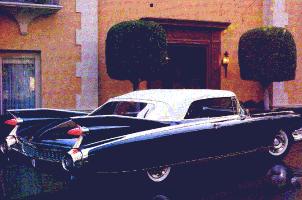 Standard equipment included all items found on DeVille’s plus heater; fog lamps; 345 horsepower V-8; remote control deck lid; radio with antenna and rear speaker; power vent windows; Six-Way power seat; air suspension; electric door locks and license frames. The Brougham was now incorporated into the line as an Italian-bodied, limited production car. A vertical crest medallion with Brougham script plate appeared on the front fenders and a single, thin molding ran from front to rear along the mid sides of the body. Styling on this car was not as radical as in the past and predicted the 1960 themes used on other Cadillac’s. The standard equipment list was pared down to match those of other Eldorado’s plus Cruise Control, Autronic Eye, air conditioning, and E-Z-Eye glass.
Standard equipment included all items found on DeVille’s plus heater; fog lamps; 345 horsepower V-8; remote control deck lid; radio with antenna and rear speaker; power vent windows; Six-Way power seat; air suspension; electric door locks and license frames. The Brougham was now incorporated into the line as an Italian-bodied, limited production car. A vertical crest medallion with Brougham script plate appeared on the front fenders and a single, thin molding ran from front to rear along the mid sides of the body. Styling on this car was not as radical as in the past and predicted the 1960 themes used on other Cadillac’s. The standard equipment list was pared down to match those of other Eldorado’s plus Cruise Control, Autronic Eye, air conditioning, and E-Z-Eye glass.
| Model Number | Body Style | Doors | Model | Seating | Factory Price | Shipping Weight | Production Total |
ELDORADO | |||||||
| 59-64 | 6437H | - | Seville Hardtop | 6 | 7401 | 4855 | 975 |
| 59-64 | 6467E | - | Biarritz Convertible | 6 | 7401 | 5060 | 1,320 |
| 59-69 | 6929P | - | Brougham Hardtop | 6 | 13075 | - | 99 |
| ELDORADO ENGINE |
- V-8 Overhead valves
- Cast iron block
- Displacement: 390 cubic inches
- Bore and stroke: 4.00 x 3.875 inches
- Compression ratio: 10.5:1
- Brake horsepower: 345 at 4800 rpm
- Five main bearings
- Hydraulic valve lifters
- Carburetion: Three (3) Rochester two-barrel Model 7015901
| CHASSIS |
- Wheelbase: 130"
- Overall Length: 225"
- Tires: 8.20 x 15
- Dual exhausts standard
- Rear axle ratios: 2.94:1 standard; 3.21:1 optional or mandatory with air conditioning
| CONVENIENCE OPTIONS |
- Radio with rear speaker ($165)
- Radio with rear speaker and remote control ($247)
- Automatic heating system on Series 75 ($179); on other models ($129)
- Six-Way power seat on 6200s except convertible ($189)
- Six-Way power seat on 60-6306-6400 and 6200 convertible ($89)
- Power window regulators ($73)
- Power vent regulators ($73)
- Air conditioning on Series 75 ($624); on other models ($474)
- Air suspension ($215)
- Autronic Eye ($55)
- Cruise Control ($97)
- Electric door locks on two-doors ($46); on four doors ($70)
- E-Z-Eye glass ($52)
- Fog lamps ($46)
- White sidewall tires 8.20 x 15 four-ply ($57 exchange)
- 8.20 x 15 six-ply ($65 exchange).
- Door guards on four doors ($7)
- Door guards on two doors ($4)
- Remote control trunk lock ($59)
- License Plate frame ($8)
- Local options
- Utility kit ($15)
- Monogram ($12)
- Acryllic Lustre finish ($20)
- Undercoating ($25)
- Radio foot switch($10)
- Gas cap lock ($4)
- Pair of rugs for front ($8)
- Pair of rugs for rear ($5)
- Note: Bucket seats were a no-cost option on the Biarritz convertible

| HISTORICAL |
- Assembly of 142,272 units was counted for the 1959 model year.
- This was the next to last season for selling the Brougham.
- Flat-top roof styling was used on four-window sedans
- Six-window jobs had sloping rooflines with rear vent panes.
- Power steering and shock absorbers were improved this year.
1959 Cadillac Series 6200
- Details
- Written by Big Block
- Category: 1950-1959
- Hits: 3600
1959 Cadillac Series 6200
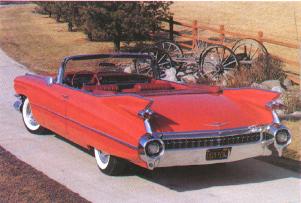 The '59 Caddy had it all -- looks, performance, and comfort. It stood as the ultimate symbol of success, impressive and -- yes -- controversial. The outrageous tail fins and jet pod taillights evoked either a love it or leave it attitude with the public. It is interesting to note that Maurice D. Hendry, author of Cadillac: Standard of the World, The Complete Seventy-Year History, refused to include a picture of the regular production '59 Cadillac in his book. He said that, "This year saw the tail fins reach a literally ridiculous height.... The fins had plenty of critics including this writer.... Nevertheless, the 1959s overall were excellent.... As cars -- rocket fins or not -- they were undeniably excellent."
The '59 Caddy had it all -- looks, performance, and comfort. It stood as the ultimate symbol of success, impressive and -- yes -- controversial. The outrageous tail fins and jet pod taillights evoked either a love it or leave it attitude with the public. It is interesting to note that Maurice D. Hendry, author of Cadillac: Standard of the World, The Complete Seventy-Year History, refused to include a picture of the regular production '59 Cadillac in his book. He said that, "This year saw the tail fins reach a literally ridiculous height.... The fins had plenty of critics including this writer.... Nevertheless, the 1959s overall were excellent.... As cars -- rocket fins or not -- they were undeniably excellent."  Walter M. P. McCall, in 80 Years of Cadillac-LaSalle agreed, commenting that the 1948 tailfins "soon became Cadillac's most famous styling feature, but with each successive series of new cars these rear fender appendages grew higher and more flamboyant. By the late 1950s they had reached ludicrous proportions and were of questionable taste." He called them "Cadillac's spectacular 'zap' fins!" Up front, McCall observed that "The new grille was a glittering cliff of chrome. And as if one toothy grille wasn't enough there was even a dummy grille across the lower rear deck of most models. A thin, horizontal blade divided the jewelled front grille into upper and lower sections. Parking and turn signal lights were paired in pods at the outer ends of the massive new front bumper. The new rear bumper had huge, chrome outer pods with backup lights recessed in their centers."
Walter M. P. McCall, in 80 Years of Cadillac-LaSalle agreed, commenting that the 1948 tailfins "soon became Cadillac's most famous styling feature, but with each successive series of new cars these rear fender appendages grew higher and more flamboyant. By the late 1950s they had reached ludicrous proportions and were of questionable taste." He called them "Cadillac's spectacular 'zap' fins!" Up front, McCall observed that "The new grille was a glittering cliff of chrome. And as if one toothy grille wasn't enough there was even a dummy grille across the lower rear deck of most models. A thin, horizontal blade divided the jewelled front grille into upper and lower sections. Parking and turn signal lights were paired in pods at the outer ends of the massive new front bumper. The new rear bumper had huge, chrome outer pods with backup lights recessed in their centers."
Of course, just about everybody knows about the monster fins on the '59 Cadillac. But how many have ever heard about the Cadillac designed around a Buick door? The 1959 Cadillac was. General Motors had gone through three expensive years of tooling up for new models and the head honchos wanted to trim costs. They decided to make the basic Buick front door a common interchangeable element throughout the GM C-body line. This was a tough directive because the door tapered rearward, but an order was an order and the Cadillac design team worked around it, turning out an unforgettable product in the process.
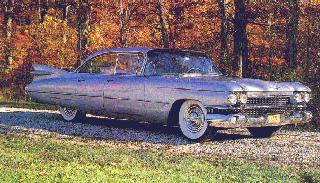
Dave Hols, now Director of Design with the General Motors Design Staff, was a designer at the Cadillac styling studio in 1956. He remembers the Buick door challenge quite well. "Boy, did you guys see those '57s parked down at the end of Mound Road?, " Hols recalls one designer asking as he came into the studio one morning. The designer was referring to the befinned 1957 Chrysler cars. Actually, Cadillac had started the great automotive fins race in 1948 after styling chief Harley Earl had sent a group of designers out to Selfridge Field near Detroit to study a Lockheed Lightening P-38, particularly its rear stabilizers. Now, almost a decade later, Chrysler's cars were out-finning Cadillac -- and in a bold way at that. In point of fact, Chrysler had temporarily wrested design leadership from GM, and that could not be tolerated.
Actually, Cadillac had started the great automotive fins race in 1948 after styling chief Harley Earl had sent a group of designers out to Selfridge Field near Detroit to study a Lockheed Lightening P-38, particularly its rear stabilizers. Now, almost a decade later, Chrysler's cars were out-finning Cadillac -- and in a bold way at that. In point of fact, Chrysler had temporarily wrested design leadership from GM, and that could not be tolerated.
Thus, Chrysler's challenge set the Cadillac design team's creative course -- the '59 Cadillac was going to have flamboyant fins. All the designers were disenchanted (some to the point of hate) with the '58 Caddy and they were going to abandon most of its design themes. And just as the 1958 Lincoln and Continental Mark III set out to "out-Cadillac" Cadillac in 1958, Cadillac found itself in the curious situation of trying to "out-Chrysler" Chrysler in 1959.
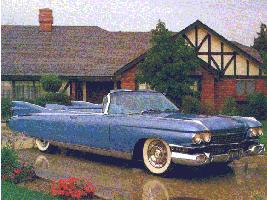
Retired Vice-President of Design, Bill Mitchell, remembers the battle with Chrysler. "I think what happened is that at the time [Virgil] Exner at Chrysler and we at GM tried to out-fin each other. I think the worst year we had was '58 when we were putting on chrome with a trowel. We had chrome on everything, and in '59 we tried to out-fin Exner. You know, we went on to '60 and '61 and brought the fins down and made them a little more sane -- a little more 'sanitary.'"
The head of GM styling at the time was Harley Earl, the Father of modern automotive design. But he was away in Europe when this inspiration came to the Cadillac design staff. "When the cat's away...."

Every designer on the project was enamored of jet aircraft. It was nothing to see a stack of books on the subject on their desks. This was an exciting time in aviation and the designers were awed by the shapes of the latest jets. True, the P-38 influence continued on the '59 Cadillac with the flow-through lines. As Mitchell said, "Seeing the P-38, you saw how you could go from the headlight straight back to the tailfin in one line." But, as Hols puts it, "By the mid-Fifties, jet aircraft were the thing." If you look at the rear of the '59 Caddy, it looks like the exhaust ports of a jet. It's no wonder the '59 Caddy looks like it's really moving even when it's just sitting in the driveway.
All the right ingredients came together for the creation of the '59 Cadillac. First, GM was doing all-new vehicles for 1959. Second, the taper in the Buick door dictated Cadillac's rearward taper. Finally, Ed Glowacke, head of design at Cadillac, wanted a new, innovative, state-of-the-art design. Cadillac could do nothing less than Chrysler and still be competitive, Glowacke thought. So he put his crew on a rush schedule to get the 1959 design completed. Work began about October 1956, with the car set for an October 1958 introduction. Compared to other GM design time-tables, that was incredibly fast and meant many late hours in the studio.
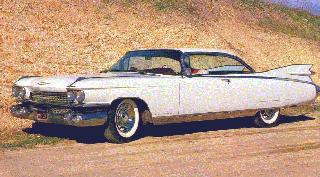
Dave Hols, working with Glowacke and crew, developed the distinctive tailfin design. Twin taillights were used because twice as many looked more expensive. Thus, nacelles were designed into the tailfins to allow for them. Chuck Puhlman and Roy Hill also worked on the design. In the end, use of the Buick door cost more than originally projected, mainly because of the taper and drop in height. Without that taper, however, the car's lines wouldn't have carried the characteristic sweep of motion that became such a distinctive part of the car's design -- and certainly we would not have seen those huge fins.
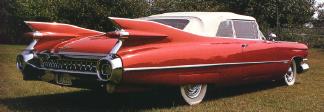
One of the most striking impressions one receives from inside the '59 Cadillac is a marvelous feeling of openness. That's because 1959 was also the "greenhouse year" at GM. The entire lineup boasted unexcelled visibility compliments of the thin pillars and abbreviated sail panel (really only a pillar itself). Sitting in the car, the driver could easily see all four corners and enjoy an almost unobstructed view in all directions. Part of the increase in visibility had to do with the design of the roof. In fact, the buyer could choose from two distinctive roof designs, the first a more traditional curved roof, the second a radical "blade-upper" flat roof. Both lent themselves to creating lavish vistas of visibility.
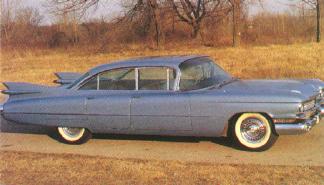
Interior planning for the 1959 Cadillac, including the Eldorado Brougham and limos, was directed by Bob Scheelk, head of Cadillac interior design. He remembers the project as a rush program; he was asked to have the instrument panel in clay -- with working instrument lights -- for the GM Board of Directors at the Tech Center in the spring of 1957, a monumental task. As it turned out, the executives approved the instrument panel for production pretty much as presented. It was quite deep because of the depth of the cowl and the rake of the wraparound windshield, which resulted in an extended shelf. Also working on the interior were Sue Vanderbilt (who had worked on Cadillac exteriors earlier); Russ Bolt, a studio engineer; and two clay modelers.
Of course, Cadillac shared a number of parts with other GM cars, mainly the structural pieces hidden from view. Cadillac's interior also shared components with its GM siblings -- items like door moldings and openings, window surrounds, and seat frames. But most of what the buyer saw, including the seat cushions and fabrics, was unique. 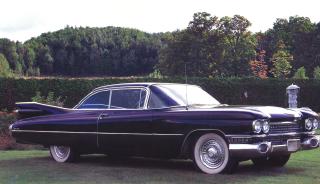 The extreme curvature of the windshield caused some rethinking regarding placement of controls and switches. For example, the section of the dash which curved around on the driver's side to the door opening was large enough that the designers referred to it as the "horn." On it, they placed the windshield-wiper controls and the power window switches. Originally, the cruise control was located there, too, but it had to be moved because it conflicted with the other controls.
The extreme curvature of the windshield caused some rethinking regarding placement of controls and switches. For example, the section of the dash which curved around on the driver's side to the door opening was large enough that the designers referred to it as the "horn." On it, they placed the windshield-wiper controls and the power window switches. Originally, the cruise control was located there, too, but it had to be moved because it conflicted with the other controls.
Because so many components were new, even the door opening mechanism for example, extra care had to be taken to maintain Cadillac's reputation for high quality. One problem in this regard was the metallic fabric used on the Fleetwood Sixty Special; it trapped the guard-hairs of women's mink coats when they sat down and hung onto the hairs when they got up. This textile problem was rapidly addressed and solved.  Scheelk came up with the colors, had some cars painted, and hosted an outdoor color show for management at Cadillac engineering on Clark Street. There, a vote was taken. Only after the formulas for the selected colors were developed and the problems worked out did the colors receive final approval. Cadillac often boasted about its Magic-Mirror acrylic lacquer finish.
Scheelk came up with the colors, had some cars painted, and hosted an outdoor color show for management at Cadillac engineering on Clark Street. There, a vote was taken. Only after the formulas for the selected colors were developed and the problems worked out did the colors receive final approval. Cadillac often boasted about its Magic-Mirror acrylic lacquer finish.
All 1959-60 Cadillacs came with Hydra-Matic, power steering, and power brakes as standard. They also featured a new direct-acting power brake booster and automatic-release parking brake. Of course, there was a long list of options: cruise control, air suspension (whose shocks now contained plastic bags of inert Freon-12 so that the gas could not mix with the shock absorber fluid), electric door locks, Autronic Eye headlight dimmer, power windows and seat, air, E-Z Eye glass, power trunk with pull-down, and more.
The '59 Caddy rode a 130-inch wheelbase and stretched 225 inches from bumper to bumper. At 54.8 inches, the two-door hardtop stood three inches lower than it had the previous year. Cadillac used a tubular-center X-frame, not only for its exceptional strength, but also because it allowed for a low body to improve appearance and enhance handling stability. The V-8 was bored for 1959, upping the displacement from 365 to 390 cid and the horsepower from 310 to 325. A four-barrel carb and dual exhausts were standard. Even the car's rear end, available with four ratios from 2.94:1 to 3.77:1, had been redesigned, but mainly for a quieter ride.
DeVille now became a distinct series, offering hardtop sedans with flat-top four-window styling and a curvier six-window roofline, plus a hardtop coupe. The Series 62 duplicated these, and added a convertible. Still pillarless (as it had since been since '57), the lush Sixty Special now shared a new 130-inch wheelbase with all other standard models, including the line-topping Eldorado trio of Seville, Biarritz, and Brougham. 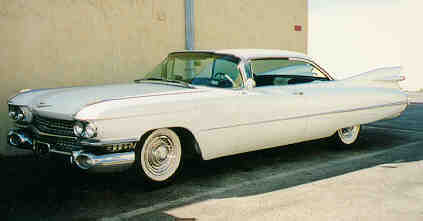 Prices were generally higher than before, with Series 62s at around $5000 and Eldos going for $7400 and up. Still, Cadillac built over 142,000 of its '59s, a fair gain on its 1958 showing. Though not appreciated then, these Caddys are now sought-after as the epitome of Fifties kitsch with their massive size, sparkling trim, and, especially, those overblown fins.
Prices were generally higher than before, with Series 62s at around $5000 and Eldos going for $7400 and up. Still, Cadillac built over 142,000 of its '59s, a fair gain on its 1958 showing. Though not appreciated then, these Caddys are now sought-after as the epitome of Fifties kitsch with their massive size, sparkling trim, and, especially, those overblown fins.
Despite a few lapses, the Fifties had been a great 10 years for Cadillac -- the greatest ever in terms of expansion. A car for the very wealthy in 1950, Cadillac was solidly entrenched by decade's end among younger buyers on the way up.
In 1959, Cadillac fielded six series: Series 6200, 6300 (DeVille), 6400 & 6900 Eldorado’s, Sixty Special Fleetwood, and 6700 Fleetwood 75.
| SERIES 6200 |
No single automotive design better characterizes the industry's late Fifties flamboyance than the 1959 Cadillac, which incorporated totally new styling:
- Large tailfins
- twin bullet taillamps
- two distinctive rooflines and roof pillar configurations
- new jewel-like grille patterns
- Matching deck latch lid beauty panels. The former 62 line was now commonly called the 6200 Series and was actually comprised of three sub-series all with similar wheelbases and lengths. Each will be treated individually here. The five base models were identifiable by their straight body rub moldings running from front wheel openings to back bumpers with crest medallions below the tip of the spear. A one-deck jeweled rear grille insert was seen. Standard equipment included
- power brakes
- power steering
- automatic transmission
- dual backup lamps
- windshield washers and two-speed wipers
- wheel discs
- outside rear view mirror
- vanity mirror
- oil filter
| I. D. NUMBERS |
- The motor serial number system adopted in 1958 was used again with numbers in the same physical locations.
- The first pair of symbols changed to "59" to designate model year.
- The third symbol (a letter listed as a Body Style Number suffix in charts below) identified model and series.
- Consecutive unit numbers began at 000001 and up
| Model Number | Body Style | Model | Seating | Factory Price | Shipping Weight | Production Total | |
| SERIES 6200 | |||||||
| 59-62 | 6229K | 4-door 6 Window Sedan | 6 | 5080 | 4835 | 23,461 | |
| 59-62 | 6229K | 6 Window Export Sedan | 6 | 5080 | 4835 | 60 | |
| 59-62 | 6239A | 4-door 4 Window Sedan | 6 | 5080 | 4770 | 14,138 | |
| 59-62 | 6237G | 2-door Hardtop Coupe | 6 | 4892 | 4690 | 21,947 | |
| 59-62 | 6267F | 2-door Convertible Coupe | 6 | 5455 | 4855 | 11,130 | |
| DEVILLE SUB-SERIES 6300 | |||||||
| 59-63 | 6329L | 4-door 6 Window Sedan | 6 | 5498 | 4850 | 19,158 | |
| 59-63 | 6339B | 4-door 4 Window Sedan | 6 | 5498 | 4825 | 12,308 | |
| 59-63 | 6337J | 2-door Coupe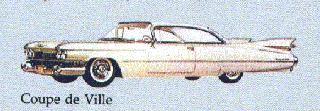 | 6 | 5252 | 4720 | 21,924 | |
NOTE: The Export Sedan was shipped in CKD form to foreign countries.
| DEVILLE SUB-SERIES 6300 |
The DeVille models, two sedans and a coupe, had script nameplates on the rear fenders eliminating the use of the front fender crest medallions. They were trimmed like 6200s otherwise. The DeVille’s also had all of the same standard equipment listed for 6200s plus power windows and Two-Way power seats.
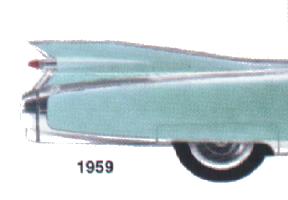
| SERIES 6200 AND 6300 ENGINES |
- V-8 Overhead valves
- Cast iron block
- Displacement: 390 cubic inches
- Bore and stroke: 4.00 x 3.875 inches
- Compression ratio: 10.5:1
- Brake horsepower: 325 at 4800 rpm
- Five main bearings
- Hydraulic valve lifters
- Carburetor: Carter AFB four-barrel Model 2814S
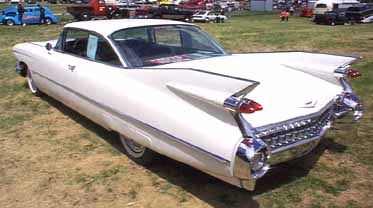
| CHASSIS |
- Wheelbase: 130"
- Overall Length: 225"
- Tires: 8.00 x 15
- Dual exhausts standard
- Rear axle ratios: 2.94:1 standard; 3.21:1 optional or mandatory with air conditioning
| POWERTRAIN OPTIONS |
The 345 horsepower Eldorado V-8 was optional on all other Cadillacs at $134.30 extra.
| CONVENIENCE OPTIONS |
- Radio with rear speaker ($165)
- Radio with rear speaker and remote control ($247)
- Automatic heating system on Series 75 ($179); on other models ($129)
- Six-Way power seat on 6200s except convertible ($189)
- Six-Way power seat on 60-6306-6400 and 6200 convertible ($89)
- Power window regulators ($73)
- Power vent regulators ($73)
- Air conditioning on Series 75 ($624); on other models ($474)
- Air suspension ($215)
- Autronic Eye ($55)
- Cruise Control ($97)
- Electric door locks on two-doors ($46); on four doors ($70)
- E-Z-Eye glass ($52)
- Fog lamps ($46)
- White sidewall tires 8.20 x 15 four-ply ($57 exchange)
- 8.20 x 15 six-ply ($65 exchange).
- Door guards on four doors ($7)
- Door guards on two doors ($4)
- Remote control trunk lock ($59)
- License Plate frame ($8)
- Local options
- Utility kit ($15)
- Monogram ($12)
- Acryllic Lustre finish ($20)
- Undercoating ($25)
- Radio foot switch($10)
- Gas cap lock ($4)
- Pair of rugs for front ($8)
- Pair of rugs for rear ($5)
- Note: Bucket seats were a no-cost option on the Biarritz convertible
| HISTORICAL |
- Assembly of 142,272 units was counted for the 1959 model year.
- This was the next to last season for selling the Brougham.
- Flat-top roof styling was used on four-window sedans
- Six-window jobs had sloping rooflines with rear vent panes.
- Power steering and shock absorbers were improved this year.
1958 Cadillac Fleetwood
- Details
- Written by Big Block
- Category: 1950-1959
- Hits: 2733
1958 Cadillac Fleetwood
| SERIES SIXTY SPECIAL FLEETWOOD |
The Sixty Special was very distinctive and rich-looking this year. Broad ribbed stainless steel fairings decorated the entire rear quarter panel, below the conical flare. Even the fender skirts featured this type of trim, which extended fully forward along the body sills. Sixty Special scripts appeared on the sides of the tailfins and a Fleetwood script nameplate adorned the rear deck lid. Standard equipment included Hydra-Matic, power brakes, power steering, power windows, and fore-and-aft power front seat.
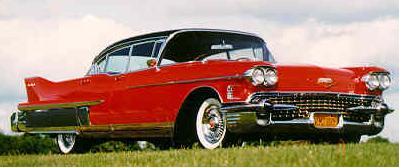
| Model Number | Body Style | Doors | Model | Seating | Factory Price | Shipping Weight | Production Total |
| SERIES SIXTY SPECIAL FLEETWOOD | |||||||
| 58M-60 | 6039X | 4-door | Hardtop Sedan | 6 | 6232 | 4930 | 12,900 |
| SERIES 75 FLEETWOOD | |||||||
| 58R-75 | 7523X | 4-door | Sedan | 9 | 8460 | 5360 | 802 |
| 58S-75 | 4533X | 4-door | Imperial Sedan | 9 | 8675 | 5475 | 730 |
| 58-86 | 8680S | - | Commercial chassis | - | - | - | 1,915 |
NOTE: The commercial chassis features a 156 inch wheelbase and was provided to professional car makers for construction of funeral cars and ambulances, etc.
| SERIES 60 SPECIAL FLEETWOOD ENGINE |
- V-8 Overhead valves
- Cast iron block
- Displacement: 365 cubic inches.
- Bore and stroke: 4.00 x 3.625 inches
- Compression ratio: 10.25:1
- Brake horsepower: 310 at 4800 rpm
- Five main bearings
- Hydraulic valve lifters
- Carburetor: Carter AFB four-barrel Model 2862S.
| SERIES 75 FLEETWOOD |
The limousine or nine-passenger long-wheelbase sedans were available once again, both with auxiliary seats and the same basic side trim as Series 62 models.

| SERIES 75 FLEETWOOD ENGINE |
- V-8 Overhead valves
- Cast iron block
- Displacement: 365 cubic inches.
- Bore and stroke: 4.00 x 3.625 inches
- Compression ratio: 10.25:1
- Brake horsepower: 310 at 4800 rpm
- Five main bearings
- Hydraulic valve lifters
- Carburetor: Carter AFB four-barrel Model 2862S.

| CHASSIS |
| Model | Wheelbase | Overall Length | Front Tread | Rear Tread | Tires |
| Series 60S 58M | 133" | 225.3" | 61" | 61" | 8.00 x 15 blackwall |
| Series 75 58R & 58S (Fleetwood) | 149.7" | 237.1" | 61" | 61" | 8.20 x 15 six-ply blackwall |
| POWERTRAIN OPTIONS |
The 335 horsepower Eldorado engine with triple two barrel carburetion was used on all Eldorado’s as standard equipment. This engine was also optional for all other Cadillac’s.
| CONVENIENCE ACCESSORIES |
- Radio with antenna and rear speaker ($164)
- Radio with rear speaker and remote control on Series 75 only ($246)
- Automatic heating system for Series 75 ($179): for other models ($129)
- Posture seat adjuster ($81)
- Six-Way seat adjuster ($103)
- Power window regulators ($108)
- E-Z-Eye Glass ($46)
- Fog lamps ($41)
- Automatic headlamp beam control ($48)
- Five (5) sabre spoke wheels ($350)
- White sidewall 8.20 x 15 four-ply tires ($55)
- Gold finish grille ($27)
- Four-door door guards ($7)
- Two-door door guards ($4)
- Remote control trunk lock ($43)
- License plate frame ($8)
- Air conditioning ($474)
- Series 75 air conditioner ($625)
- Eldorado engine in lower models ($134)
- Air suspension ($214)
- Electric door locks on coupes ($35); on sedans ($57)
- Local dealer options:
- Utility kit ($15)
- Monogram ($12)
- Blue Coral waxing ($25)
- Undercoating ($5)
- Lubrication agreement ($34)
| I. D. NUMBERS |
- Serial numbers now used a three symbol prefix.
- The first pair of numerical symbols "58" designated model year.
- A one-letter alphabetical code (included as part of model number in charts below) indicated model and series.
- Each prefix was followed by the consecutive unit number which started at 000001 and up.
- The serial number was located at the front of the lefthand frame side bar.
- Motor serial numbers again matched and were found on the center lefthand side of the block above the oil pan.
1958 Cadillac Eldorado
- Details
- Written by Big Block
- Category: 1950-1959
- Hits: 2864
1958 Cadillac Eldorado
For 1958, Cadillac stood more or less pat on a winning hand. Styling changes involved minor sheetmetal reshaping and ornamentation shuffling, and all models acquired the new four-headlamp system, first seen at Cadillac on the Brougham, in line with an industry trend. Eldorado performance was substantially improved with the adoption of three two-barrel carburetors, which boosted output to 335 bhp, 25 bhp up on the single-four-barrel engine used elsewhere in the line.
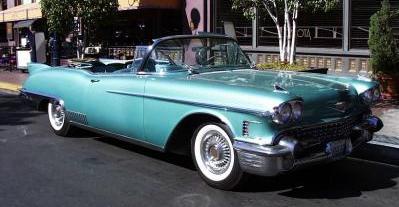
The Brougham's astronomical price was unchanged, but the Seville 40 and Biarritz, which consistently bore identical price tags, rose a startling $762. The timing of such a substantial increase proved to be ill-advised in this deep recession year and sales fell by more than half. The Brougham fared little better, production stopping at a mere 304 units.
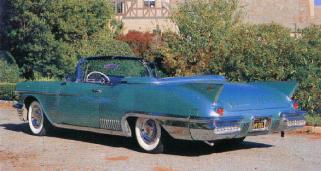
| I. D. NUMBERS |
- Serial numbers now used a three symbol prefix.
- The first pair of numerical symbols "58" designated model year.
- A one-letter alphabetical code (included as part of model number in charts below) indicated model and series.
- Each prefix was followed by the consecutive unit number which started at 000001 and up.
- The serial number was located at the front of the left hand frame side bar.
- Motor serial numbers again matched and were found on the center left hand side of the block above the oil pan.
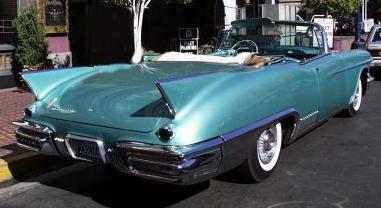
| Model Number | Body Style | Model | Seating | Factory Price | Shipping Weight | Production Total | |
| SERIES 62 ELDORADO SPECIAL | |||||||
| 58H-62 | 6237SDX | 2-door Coupe Seville | 6 | 7500 | 4910 | 855 | |
| 58E-62 | 6267SX | 2-door Biarritz Convertible | 6 | 7500 | 5070 | 815 | |
| 58-62 | 6267SSX | 2-door Special Eldorado Coupe | 6 | - | - | 1 | |
| SERIES 70 FLEETWOOD ELDORADO BROUGHAM | |||||||
| 58P-70 | 7059X | 4-door Hardtop Sedan | 6 | 13,074 | 5,315 | 304 | |
- The Special Eldorado Coupe was a special order model built in limited quantities.
- Five specially equipped Eldorado Biarritz convertibles were also built.
- The symbol "X" after Body Style Number indicates power windows and seat standard.
| ENGINE |
- V-8 Overhead valves
- Cast iron block
- Displacement: 365 cubic inches.
- Bore and stroke: 4.00 x 3.625 inches
- Compression ratio: 10.25:1
- Brake horsepower: 355 at 4800 rpm
- Five main bearings
- Hydraulic valve lifters
- Carburetor: Three (3) Rochester two-barrel Model 7015801
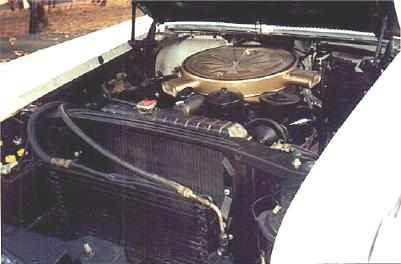
| SERIES 70 FLEETWOOD ELDORADO BROUGHAM |
 The major change for the Eldorado Brougham was seen inside the car. The interior upper door panels were now finished in leather instead of the metal finish used in 1957. New wheel covers also appeared. Forty-four trim combinations were available, along with fifteen special monotone paint colors. This was the last year for domestic production of the hand built Brougham at Cadillac's Detroit factory, as future manufacturing of the special bodies was to be done by Pininfarina of Turin, Italy.
The major change for the Eldorado Brougham was seen inside the car. The interior upper door panels were now finished in leather instead of the metal finish used in 1957. New wheel covers also appeared. Forty-four trim combinations were available, along with fifteen special monotone paint colors. This was the last year for domestic production of the hand built Brougham at Cadillac's Detroit factory, as future manufacturing of the special bodies was to be done by Pininfarina of Turin, Italy. | SERIES 70 FLEETWOOD ELDORADO BROUGHAM ENGINE |
- V-8 Overhead valves
- Cast iron block
- Displacement: 365 cubic inches.
- Bore and stroke: 4.00 x 3.625 inches
- Compression ratio: 10.25:1
- Brake horsepower: 310 at 4800 rpm
- Five main bearings
- Hydraulic valve lifters
- Carburetor: Carter AFB four-barrel Model 2862S.
| CHASSIS |
| Model | Wheelbase | Overall Length | Front Tread | Rear Tread | Tires |
| Series 62 58H & 58E (Eldorado) | 129.5 | 223.4" | 61" | 61" | 8.20 x 15 whitewall |
| Series 70 (Eldorado) | 126" | 216.3 | 61" | 61" | 8.40 x 15 high-speed thin whitewall |
| CONVENIENCE ACCESSORIES |
- Radio with antenna and rear speaker ($164)
- Automatic heating system ($129)
- Posture seat adjuster ($81)
- Six-Way seat adjuster ($103)
- Power window regulators ($108)
- E-Z-Eye Glass ($46)
- Fog lamps ($41)
- Automatic headlamp beam control ($48)
- Five (5) sabre spoke wheels ($350)
- White sidewall 8.20 x 15 four-ply tires ($55)
- Gold finish grille on Eldorado (no charge)
- Four-door door guards ($7)
- Two-door door guards ($4)
- Remote control trunk lock ($43)
- License plate frame ($8)
- Air conditioning ($474)
- Air suspension ($214)
- Electric door locks on coupes ($35); on sedans ($57)
- Local dealer options:
- Utility kit ($15)
- Monogram ($12)
- Blue Coral waxing ($25)
- Undercoating ($5)
- Lubrication agreement ($34)
| HISTORICAL |
Five special Eldorado Biarritz convertibles were built with completely automatic top riser mechanisms and metal tonneaus and incorporated humidity sensors which activated the top riser mechanism in case of rain. These cars had four place bucket seating and custom leather interior trims including driveshaft tunnel coverings. The 1958 Eldorado Brougham is a certified Milestone Car.
1958 Cadillac Series 62
- Details
- Written by Big Block
- Category: 1950-1959
- Hits: 3907
1958 Cadillac Series 62
 The volume Cadillac’s were heavily face lifted for 1958 in a manner typical of GM that year. Perhaps the most garish Caddy’s yet, they were laden with chrome and far less stylish than previous postwar models. Sales were poor, though a nationwide recession was probably more to blame than the baroque styling, which was, after all, in vogue. At 121,778 units, model year production was lower than at any time since 1954. Symbolizing the fall in fortunes was a V-8 slightly detuned in a faint nod toward fuel economy, limited to a single 310-bhp version for all models.
The volume Cadillac’s were heavily face lifted for 1958 in a manner typical of GM that year. Perhaps the most garish Caddy’s yet, they were laden with chrome and far less stylish than previous postwar models. Sales were poor, though a nationwide recession was probably more to blame than the baroque styling, which was, after all, in vogue. At 121,778 units, model year production was lower than at any time since 1954. Symbolizing the fall in fortunes was a V-8 slightly detuned in a faint nod toward fuel economy, limited to a single 310-bhp version for all models.
Forecasting the future, DeVille became a 62 sub-series for '58, and pillared sedans were temporarily eliminated. The 62 line also gained a hardtop sedan with extended rear deck. All models were available with cruise control, high-pressure cooling system, two-speaker radio with automatic signal-seeking, and automatic parking brake release. A special show Eldorado introduced a "thinking" convertible top that raised itself and the side windows when a sensor detected raindrops, but this was another gimmick that came to nothing.
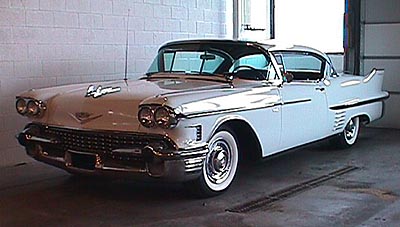
| SERIES 62 |
Cadillac’s for 1958 were basically carryover models with a facelift on all but the Brougham. There was a new grille featuring multiple round "cleats" at the intersection of horizontal and vertical members. The grille insert was wider and the bumper guards were positioned lower to the parking lamps. New quad (dual) headlamps were seen throughout all lines and small chrome fins decorated front fenders. Tailfins were a bit less pronounced and trim attachments were revised. The word Cadillac appeared, in block letters, on the fins of Series 62 base models. On the sides of the cars there were five longer horizontal windsplits ahead of the unskirted rear wheel housings; front fender horizontal moldings with crests placed above at the trailing edge and no rocker sill trim. The convertible, Coupe DeVille, and Sedan DeVille used solid metal trim on the lower half of the conical projectile flares, while other models had a thin ridge molding in the same location. On 62 Eldorado’s a V-shaped ornament and model identification script were mounted to the deck lid. The two luxury Cadillac’s also had ten vertical chevron slashes ahead of the open rear wheel housings and crest medallions on the flanks of tailfins. Broad, sculptured beauty panels decorated the lower rear quarters on Eldorado’s and extended around the wheel opening to stretch along the body sills. Standard equipment was the same as the previous year. All-new was an extended deck Series sedan, which was 8.5 inches longer than other base models.
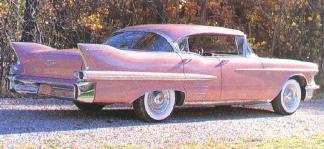
| I. D. NUMBERS |
- Serial numbers now used a three symbol prefix.
- The first pair of numerical symbols "58" designated model year.
- A one-letter alphabetical code (included as part of model number in charts below) indicated model and series.
- Each prefix was followed by the consecutive unit number which started at 000001 and up.
- The serial number was located at the front of the lefthand frame side bar.
- Motor serial numbers again matched and were found on the center left hand side of the block above the oil pan.
| Model Number | Body Style | Doors | Model | Seating | Factory Price | Shipping Weight | Production Total |
| 58K-62 | 6239(X) | 4-door | Hardtop Sedan | 6 | 4891 | 4675 | 13,335 |
| 58K-62 | 6239(X) | - | Export Sedan | 6 | 4891 | 4675 | 204 |
| 58N-62 | 6239E(X) | - | Extended Deck Sedan | 6 | 5079 | 4770 | 20,952 |
| 58L-62 | 6239EDX | 4-door | Sedan DeVille | 6 | 5497 | 4855 | 23,989 |
| 58G-62 | 6237(X) | 2-door | Hardtop Coupe | 6 | 4784 | 4630 | 18,736 |
| 58J-62 | 6237DX | 2-door | Coupe DeVille | 6 | 5231 | 4705 | 18,414 |
| 58F-62 | 6267X | 2-door | Convertible Coupe | 6 | 5454 | 4845 | 7,825 |
| 58-62 | 62 | - | Chassis only | - | - | - | 1 |
- The export sedan was shipped in CKD form to foreign countries.
- The symbol "X", in brackets after Body Style Number, indicates power windows and seat optional; without brackets indicates these features standard.
- Style Number 6239E(X) is the new Extended Deck Sedan.
| ENGINE |
- V-8 Overhead valves
- Cast iron block
- Displacement: 365 cubic inches.
- Bore and stroke: 4.00 x 3.625 inches
- Compression ratio: 10.25:1
- Brake horsepower: 310 at 4800 rpm
- Five main bearings
- Hydraulic valve lifters
- Carburetor: Carter AFB four-barrel Model 2862S.
| CHASSIS |
| Model | Wheelbase | Overall Length | Front Tread | Rear Tread | Tires |
| Series 62 58K | 129.5" | 216.8" | 61" | 61" | 8.00 x 15 blackwall |
| Series 62 58G, 58J, & 58F | 129.5" | 221.8" | 61" | 61" | 8.00 x 15 blackwall |
| Series 62 58N & 58L | 129.5" | 225.3" | 61" | 61" | 8.00 x 15 blackwall |
| POWERTRAIN OPTIONS |
The 335 horsepower Eldorado engine with triple two barrel carburetion was used on all Eldorado’s as standard equipment. This engine was also optional for all other Cadillac’s.
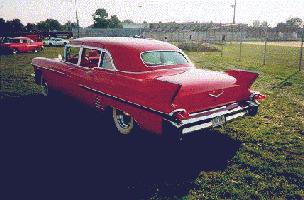
| CONVENIENCE ACCESSORIES |
- Radio with antenna and rear speaker ($164)
- Automatic heating system ($129)
- Posture seat adjuster ($81)
- Six-Way seat adjuster ($103)
- Power window regulators ($108)
- E-Z-Eye Glass ($46)
- Fog lamps ($41)
- Automatic headlamp beam control ($48)
- Five (5) sabre spoke wheels ($350)
- White sidewall 8.20 x 15 four-ply tires ($55)
- Gold finish grille ($27)
- Four-door door guards ($7)
- Two-door door guards ($4)
- Remote control trunk lock ($43)
- License plate frame ($8)
- Air conditioning ($474)
- Eldorado engine in lower models ($134)
- Air suspension ($214)
- Electric door locks on coupes ($35); on sedans ($57)
- Local dealer options:
- Utility kit ($15)
- Monogram ($12)
- Blue Coral waxing ($25)
- Undercoating ($5)
- Lubrication agreement ($34)